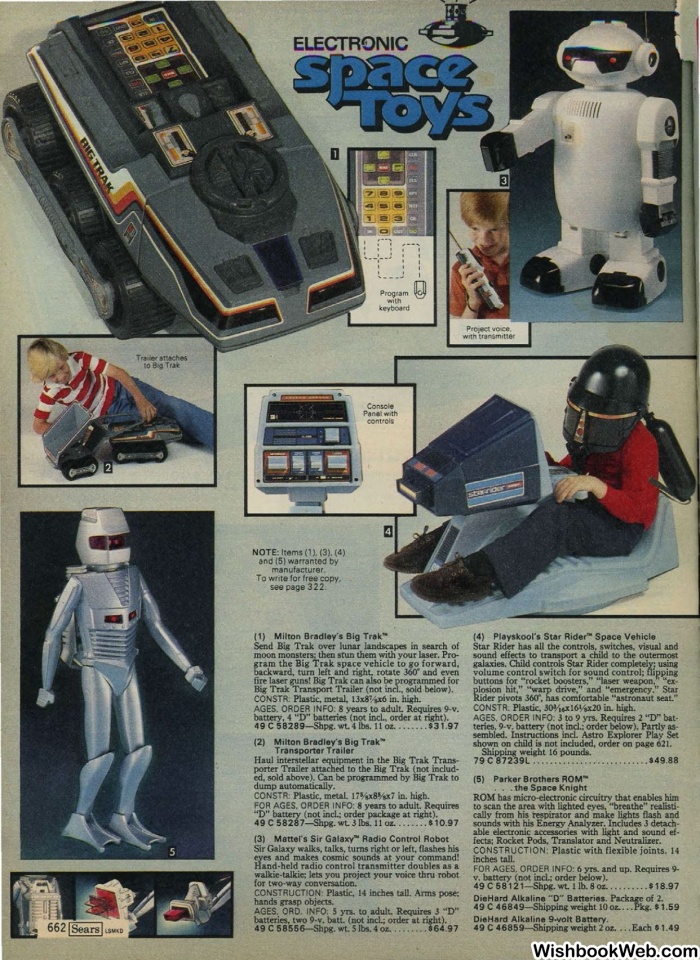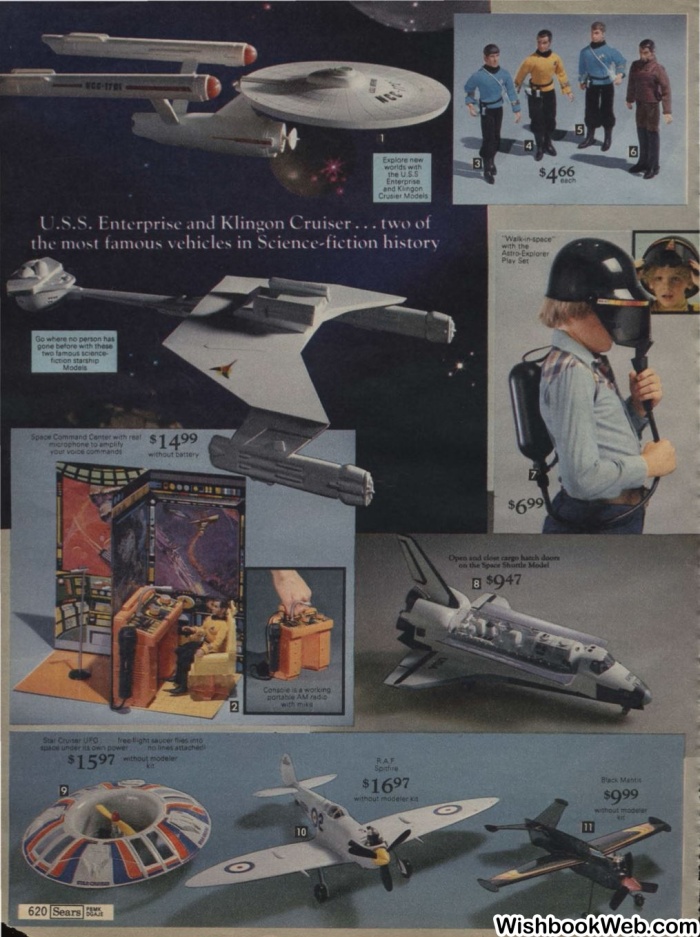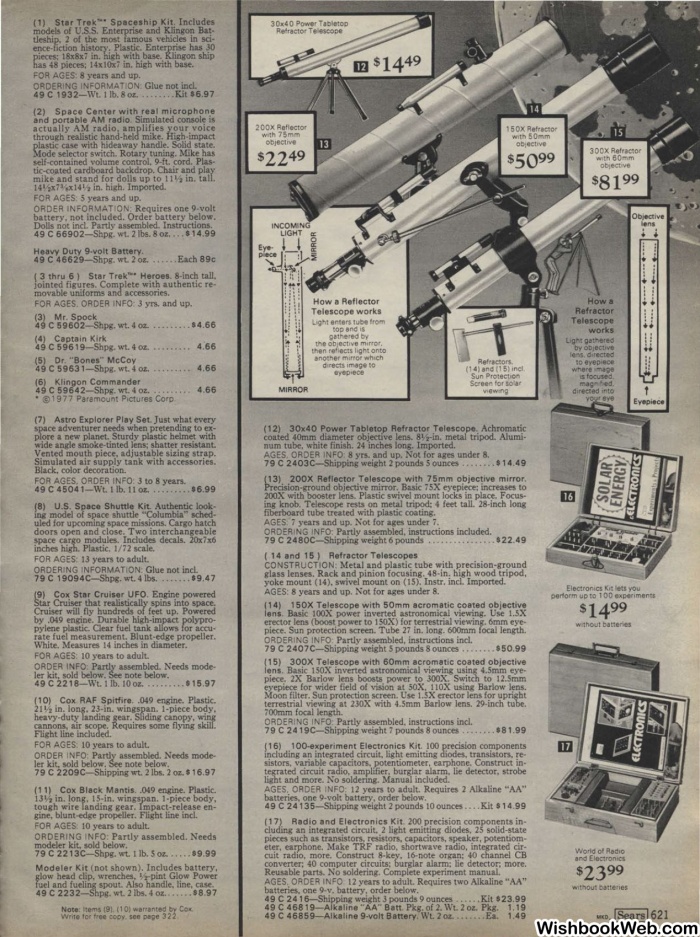Recollections / December 12, 2018
As part of this year’s holiday “festivities,” my fellow US-based Mutants have mockingly given me a couple of the toy pages from a 1979 American catalog to look at in the hope of stimulating some idiosyncratic British take on the very different world of US toys, and possibly provoking a bit of retrospective seasonal gift envy. I can almost hear them now, chortling away mirthlessly in their La-Z-Boy recliners in their respective dens, or wherever the fuck it is that North Americans go to chortle. But they won’t break me; I’m made of sterner stuff.
I won’t bother commenting on the grotesque consumerist juggernaut pantomime that is Christmas: a trace of affection for it lingers on in me like the sporadic twitch of a dose of shingles lying dormant in the system, and it’s the supreme act of entitled Western privilege to moan about the bloody thing, so I’ll just say that I do still enjoy the twinkle of fairy lights, if not much else. But back in 1979, Christmas occupied my thoughts pretty much from Easter onwards. We’ve spoken before on the site about British retail catalogues, and it’s a cliché that, for many people of my generation, studying the toy pages of the catalog so obsessively that it felt like an act of sympathetic magic was part and parcel of the Christmas experience. In fact, it sort of felt like that was Christmas.
The pages in question come from something called the Sears “Wish Book,” a simple “catalog” being too prosaic for our American chums, who don’t like anything not mawkish enough to actually make you vom up your lunch. Now if we’d been talking about toys from, say, 1975, a humiliating and bellicose display of toy superiority would probably have ensued, but by the time the decade was ending, British household incomes had been rising. The country was growing increasingly materialistic and acquisitive—Margaret Thatcher had recently been elected, which should give you a clue about the mood—and American toys had begun to flood the market, reinforcing every negative stereotype our parents had of the Yanks as brash, loud, and made of plastic whilst causing a generation of British children to foam at the mouth with desire.
So by 1979, even we humble Brits had Big Trak (though with a clean-looking white hull that evoked scientific futurism and brought out the hot-tub speed lines better than the weird gunmetal grey body that you lot had, which made it look like an automated sewer scraper—you do love your gunmetal greys over there, don’t you?), a strangely pointless prestige toy. The one child I knew who was spoiled enough to own one admitted—to the shock and disgust of the rest of us, who had presumed that simply possessing a Big Trak meant an existence of ongoing technical bliss—that he’d played with it precisely twice because it was so boring. In real life, the smooth interaction with family and the domestic environment promised by the adverts on TV crumbled in the face of how impossible it was to get the fucking thing to cross the room without smashing into something, much less delivering an apple and lasering the family dog in the face. (Comparison with the US commercial is also instructive, and probably hints at a difference in domestic hygiene confidence between the two nations.)
I don’t think we had Sir Galaxy, but as it looks astoundingly shit and I’ve never been much of a fan of robots with massive feet containing wheels (well, except for one), that’s no great loss. We—though not actually me, unfortunately—did have ROM the Space Knight, who still looks as gloriously alien as he did back then. The child in the catalog picture is wearing a Placo Astro Explorer Play Set, which fits nicely on the Vader continuum that includes Warning and the cover art of Black Sabbath’s Never Say Die: with its “air support unit” (apparently equipped with bellows), it adds another element of eerie alien excitement to the whole set up.
There is one thing on these pages, though, that actually does send a chill of ludic envy running through me—one thing that summarizes perfectly all the dreams of my nine-year-old self: the Playskool SR1 Star Rider. If I had known of the existence of what was basically a full-sized version of Starbird, it’s unlikely I’d have survived the revelation. In fact, I’m glad I was never given anything like the SR1 Star Rider (Tagline: “For adventures past the boundaries of space and time. Free from the gravity that holds the mind”) for Christmas, because I suspect the resulting jolt of futurist ecstasy might have definitively compromised what was already a fairly fragile relationship with reality. Even now, when I’m approaching 50 and my lot is more gradual physical decomposition and existential exhaustion than childlike glee, and when the infantile excitements of most of the dreck in these catalogs arouse about as much emotion in me as watching CCTV footage of a car park, the thought of swooping through gaudy Roger Dean-esque infinities aboard my own space scooter, deafening all I pass with my electronic screeching, still gets my pulse going.
Clearly based on the Millenium Falcon’s gunnery positions, the SR1 was equipped with handlebars that allowed it to rotate on its axis at startling, mechanical bull-like speed, and generated sound effects that (as this brief tutorial demonstrates) were closer in spirit to the Power Electronics of something like Whitehouse or Ramleh than to anything a British child might conceivably think of as “play.” I mean, even the catalog describes the emissions as “piercing,” which is not how you usually speak about something you’re trying to gull parents into buying buy for their kids.
But the SR1 was just too damn American to exist on our drizzly isle. With our flimsy plywood walls and doors, it’s hard to imagine British parents of the 1970s, still half-attached to the idea that children should be seen and not heard, agreeing to put up with the thing’s manic beeping, which sounds more like a “reactor meltdown in progress” warning than the reassuring hum of a smoothly functioning space scooter. Not to mention footing the bill for it—not many British parents of the 1970s would have been inclined to cough up the best part of 50 quid for one toy, even if it was a shrieking, bleeping star sledge, and the inevitable cost-cutting that would have been involved in the production of a domestic version—because importing them would probably have bankrupt the country—would have meant something tragically inferior. Add to that that the SR1 was also so bastard big that you would have needed the best part of the entire garage of your typical British semi to contain it. I appreciate that you lot had vast physical and existential spaces to fill over there, but toys that are actually as large as the children playing with them—and in some cases bigger than the adults buying them—seem just a tad over the top.
It would be another six years before we Brits would release what now seems quite obviously our riposte to the SR1—Clive Sinclair’s quixotic (read: demented) C5—which was at once both more and far less practical. Another vacuum-formed vehicle equipped with rudimentary technologies and handlebars that spun it violently in one direction or another, the C5 did actually move—albeit slowly—but only through the damp autumnscapes of provincial Britain, and at a height above the road surface that practically guaranteed riders would be drenched with rainwater or suffer severe injury.
So no, neither I nor any other British kid got an SR1 for Christmas 1979. Yes, fellow mutants, yuk it up: you lot had the biggest, most deafening toys. If an adult-sized version of the SR1 were available today, and it were possible to own one without coming across as the worst kind of infantile “nerd” wanker, I would buy one in a snap. I can’t really complain about my haul that year, though: my endless nagging of every working adult I knew finally paid off, and I received a copy of Alien: The Illustrated Story, which informed me that a crucial part of adult life was using the word “fuck” as often as possible. It’s a festive lesson that, I think we can all agree, every child should learn.
![]() Richard McKenna grew up in the visionary utopia of 1970s South Yorkshire and now ekes out a living among the crumbling ruins of Rome, from whence he dreams of being rescued by the Terran Trade Authority.
Richard McKenna grew up in the visionary utopia of 1970s South Yorkshire and now ekes out a living among the crumbling ruins of Rome, from whence he dreams of being rescued by the Terran Trade Authority.






That helmet and backpack combo on the middle page: “Walk-in-space” with the Astro-Explorer Play Set
More like ‘burn books with the Fahrenheit 451 role playing set’. I haven’t seen an outfit this dystopian since the bandaged traffic warden with a gun in Threads.